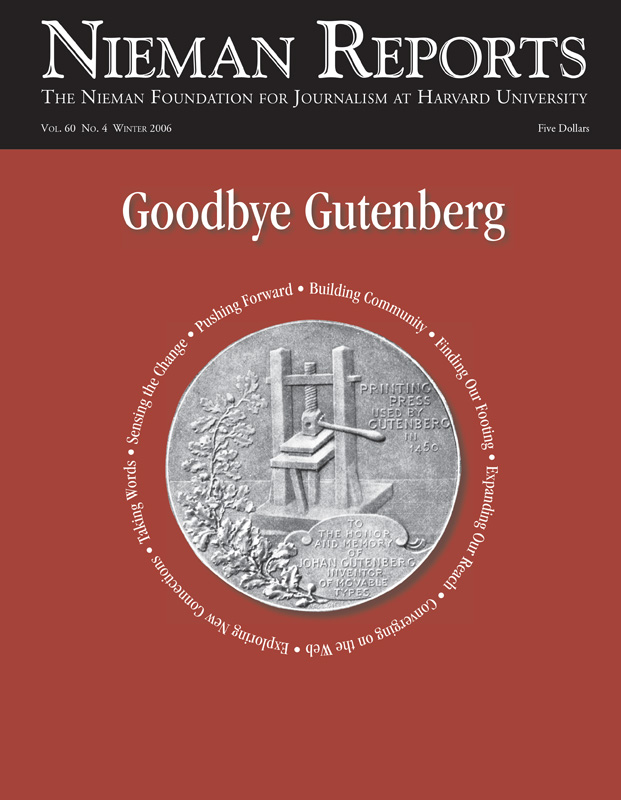
A short time ago two of my colleagues returned from a visit with one of the great technology innovators of our age, who blithely told them that newspapers would disappear within five years—or perhaps seven years, to be generous. This man did allow that there are some things he truly enjoys about curling up with a good newspaper. "I'd also like to leave work early and spend time throwing a stick with my dog," he said. "But I don't have time for that, either."
I believe in the future of journalism. That billionaire who likened my print edition to his dog and a stick still reads The Wall Street Journal every day online. I even believe that print has a future. But we are not going to get there without working harder and thinking smarter.
There is no magic wand to wave or time machine we can climb into, to return us to when newspapers enjoyed monopolies in many of their markets, making their investors and employees comfortable, if not rich. Newspapers struggle now with broken business models and expanding competition, amid rampant disrespect by the young and Web-adept.
In this environment, journalists must decide whom we are going to serve with our journalism and how to be paid for that service. And we have to be disciplined and hardheaded about that decision. While I might want to write about global affairs and culture, to do so means I must offer something not available in The New York Times or on BBC.com. If I want to write about American politics, I'll need to outperform The Washington Post. If I want to cover business, I'd better keep my sights on The Wall Street Journal, CNBC and Yahoo! Finance. And if I want to be the leading—or only—daily in my local metropolis, maybe I'll need to figure out how to publish every high school wrestling result in the nine nearest counties.
Most of us have recognized that our journalism is more important than the means of delivering it. Newspapers and magazines have Web sites, and some of those are experiencing growth in revenues of 20 percent a year or more, even as their print editions struggle to eke out single-digit growth rates—and struggle to prevent their circulation from declining. Given this situation, many are tempted to believe that if they can just shift faster to the digital zone, their troubles will end.
There are two problems with this way of thinking.
It is a blessing and a curse that because of differences in advertising rates a print reader is worth three times as much to a news organization as an online user. Ad rates (and possibly subscription charges) will have to grow much faster than the market now seems to allow before this balance shifts.
More terrifying, search engines such as Google and Yahoo! and their budding competitors are sucking much of the oxygen out of the room. Advertisers who might otherwise keep much of their budgets in print and put the bulk of their Web spending on news sites are instead plunging into search. They hope to target directly the people whose Web destinations indicate they are prospects to buy the advertisers' goods or services. Search on the Web promises to cure the classic problem of advertising (and the resulting bonanza for publishers) that is perhaps best summed up by the famously wry comment by a major retailer that "half of my advertising spending is wasted; I just don't know which half."
While this presents a huge challenge for us, there are things we can do to enable us to survive and, ultimately, to thrive.
Fitting the Web and Print Together
Powerful journalistic models—such as Bloomberg's—have emerged in the electronic space and others undoubtedly will. Of course, news organizations that have grown up in print confront a task that can be more complicated; while they pump increasing resources into growing their electronic side, they must also continue to nurture the print publications that still provide the bulk of their revenue. At The Wall Street Journal, we are learning how to operate complementary print and online editions, and we're having considerable success marketing the two editions together.
The Web's advantages are speed and efficiency of delivery, personal selectivity, availability on demand, and the almost cost-free capability to store additional content and accept additional users. Print favors portability, the relative ease of reading sustained narratives and longer arguments, and serendipity. By serendipity I mean the ability of readers to scan full pages or portions of pages and spot headlines and stories that they would not have expected to be interested in. There is a wonderful sense of discovery in learning something you didn't think you needed to know, and print still delivers that best.
To make best use of both editions, we need to be increasingly disciplined about what goes where. More and more of our readers will get an increasing share of their spot news electronically—and we hope it will come from us. That puts the burden on the print edition to emphasize what it does best—compelling narratives, investigations, explanations, trend-spotters, context, exclusive interviews—what I call "scoops of fact" and "scoops of ideas." That doesn't mean that the print edition abandons reporting of pure spot news. While our readers increasingly can get their news from the Web, they don't always do it—they might have meetings all day or a kid's soccer game to attend—and when that happens they depend on us to protect them the next morning. But our newspaper will increasingly deliver that pure spot news in the form of briefs and summaries, taking a progressively smaller share of total space.
It isn't enough just to reorder how we deliver what we've always delivered. News organizations need to focus hard on what it is that should be delivered and to whom. What audience are we trying to attract? Once we decide that, our next step is to find ways to provide coverage that in some ways uniquely suits that audience, coverage that they can't easily get elsewhere or assemble for themselves.
My friend Richard Lambert, the distinguished former editor of the Financial Times, reminded me the other day that market statistics used to be a prime selling point—perhaps the prime selling point—for our respective publications. The Wall Street Journal doubled its circulation to two million from one million between the 1960's and the 1980's, in part because it provided over-the-counter stock quotations and other financial data unavailable elsewhere. Now such data are available everywhere electronically, typically free of charge. So the Journal has cut out eight pages of such stats in recent years and will cut more. We are replacing it with content that we hope will hold similar allure—more exclusive stories and proprietary stats that give deeper insight into what the markets are doing than can be gleaned from simple stock-price quotations.
News organizations also should explore alternative business models. The Los Angeles Times has been undergoing turmoil over cost cuts when its profit margins—the ratio of profit to revenue—are in the neighborhood of 20 percent. Those are great margins for many businesses, but publicly traded companies usually must hold out the promise of growth, and that appears to be the missing element in Los Angeles and with the Tribune Company that owns the Times.
This suggests that an alternative might be ownership by public-spirited citizens with enough means not to need a market rate of return on the investment—although, as evidenced recently in Philadelphia and Santa Barbara, California, local ownership is not a panacea for tensions between the business and journalistic sides of news organizations. Another model might be employee ownership. A third might involve some form of nonprofit structure, such as has played a role at the St. Petersburg Times.
Whether the business models are conventional or unconventional—and I think they will be both—the public's need and desire for what news organizations uniquely produce will ultimately be enough for them to succeed financially. Some Web advocates argue against this assumption, contending that the Internet has transformed citizens into becoming their own journalists, thereby obliterating the need people had for journalists to act as information gatekeepers. People will put online what they see and believe and, with the help of technology, these Web advocates contend, good information will overwhelm the bad.
I don't doubt that this dynamic happens sometimes. Witness how fast search engines like Google and Yahoo! can deliver fascinating arrays of information about a limitless universe of people, events and things. But the capacity to search won't satisfy humanity's quest for knowledge if the content available isn't informed by the rigor of inquiry that resides at the core of journalism's standards and ethics. Even with the incredible search abilities that exist on the Web today it is difficult to find a reliable and comprehensive analysis of a complicated issue.
People will continue to need information relevant to their lives that is quickly and carefully gathered, sifted, verified and reported to them. Said another way, they will need journalism. Our challenge is to find the best ways to accomplish this in a world that promises to change even more rapidly in the future than it has in the past.
Paul E. Steiger is managing editor of The Wall Street Journal and a vice president of Dow Jones & Company.


